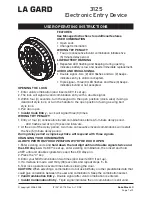
1.
Introduction
The PISO-DA4U/DA8U/DA16U and PIO-DA4U/DA8U/DA16U analog output
boards support the universal PCI interface (3.3 V/5 V PCI). These cards are
equipped with 4/8/16 14-bit analog output channels. Each of the D/A channels
features a double-buffered latch. The PISO-DAxU and the PIO-DAxU series
cards (universal PCI versions) are fully compatible with the PIO-DAx cards (PCI
versions) and users can directly replace the PIO-DAx with either the PISO-DAxU
or the PIO-DAxU without any need for software/driver modification.
Adds high-voltage isolation design has been added to the PISO-DA series which
provides the ability to protect the user’s computer from unexpected voltage
surges via the built-in high-quality isolation components that feature a 2500 V
DC
bus-type isolation. For both the PIO-DA and the PISO-DA series, the voltage
output range is from -10 V to +10 V, with a current output range from 0 to 20 mA.
In addition, the PISO-DA and PIO-DA series also provide the following
advantages:
1. Accurate and easy-to-use calibration
ICP DAS provides software-based calibration instead of the previous
manual calibration so that jumpers and trim-pots are no longer required.
The calibration information can be saved in EEPROM for long-term use.
2. Individual channel configuration
Every channel can be individually configured as either voltage or current
output.
3. Card ID
ICP DAS provides a Card ID function for both the PISO-DA series and
the PIO-DA4U/DA8U/DA16U (version 1.1 or above series). Users can set
a unique card ID for each card, which can then be used to individually
identify then if more than two boards are used in a single PC.
Note: This card needs a
±
12 V power supply, which can be found in either a
regular PC or an Industrial PC.
!
PIO-DA/PISO-DA Series User Manual (Ver.2.9, Feb. 2011, PMH-009-29 )
3




































